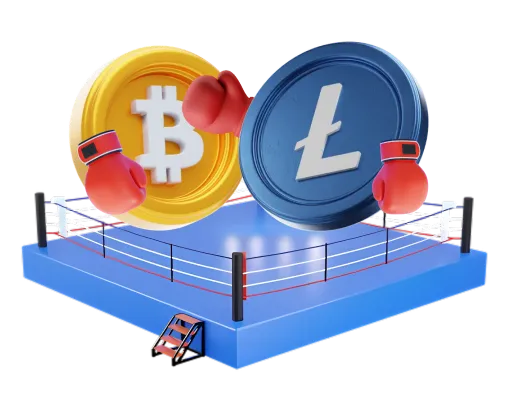Litecoin vs Bitcoin: Key Differences and Which to Choose

Litecoin and Bitcoin are two of the earliest and most recognized cryptocurrencies, frequently compared due to their shared origins and technical foundations. While both were created to facilitate peer-to-peer digital payments without intermediaries, they possess distinct operational differences. This article provides a detailed comparison of their key features, history, and primary use cases to clarify their respective roles in the digital asset landscape.
A Brief History of Bitcoin and Litecoin
Bitcoin
In 2008, the pseudonymous Satoshi Nakamoto published the whitepaper “Bitcoin: A Peer-to-Peer Electronic Cash System.” It detailed a decentralized online payment system enabling direct transactions between users without a central authority. To prevent issues like the double-spending of digital funds, Nakamoto designed a tamper-proof public ledger known as the blockchain. The first Bitcoin (BTC) was mined on January 3, 2009, launching the world's first cryptocurrency.
Litecoin
In 2011, former Google engineer Charlie Lee created Litecoin by modifying Bitcoin's open-source code. Lee aimed to address what he saw as Bitcoin's limitations, particularly its transaction speed, which he believed could slow its adoption. He positioned Litecoin as a lighter, faster alternative, famously describing it as "the silver to Bitcoin's gold." While Litecoin retained core Bitcoin concepts like the Proof-of-Work (PoW) consensus mechanism and supply-halving events, it introduced key changes. It uses the Scrypt hashing algorithm instead of Bitcoin's SHA-256 and generates new blocks approximately four times faster.
Key Differences Explained
Litecoin and Bitcoin differ in key aspects of their technical architecture and operations, most notably their mining algorithms.
Mining Algorithm
Bitcoin employs the SHA-256 mining algorithm, a function that is computationally intensive and requires specialized, high-performance hardware known as Application-Specific Integrated Circuits (ASICs).
Litecoin, however, uses the Scrypt mining algorithm. Scrypt is more memory-intensive and was designed to be more accessible for miners using consumer-grade hardware like Graphics Processing Units (GPUs). While Scrypt-specific ASICs now exist, the fundamental difference in algorithms remains a key distinction.
Transaction Speed and Block Time
Bitcoin's network creates a new block approximately every 10 minutes, which is the average time needed to confirm a transaction. During periods of high demand, this time can increase, and transactions with higher fees are often prioritized by miners. Bitcoin's network can process approximately 5 to 7 transactions per second.
Litecoin features a much faster block time, generating a new block every 2.5 minutes on average. This allows for quicker transaction confirmations, making it more suitable for time-sensitive payments. Consequently, Litecoin's network can handle a higher volume, processing around 56 transactions per second.
Security
Bitcoin is widely considered the most secure public blockchain. It is protected by a Proof-of-Work mechanism using the SHA-256 hash function and is supported by an immense amount of computational power (hash rate). This massive, decentralized network of miners makes Bitcoin extremely resilient to attacks.
Litecoin also utilizes a robust Proof-of-Work consensus model with its Scrypt hash function and has an excellent security track record. However, its network hash rate is significantly lower than Bitcoin's. While still very secure, its smaller network size makes it theoretically less difficult to attack in comparison to Bitcoin.
Expanding Utility and DeFi
Originally created for peer-to-peer payments, Bitcoin has primarily been adopted as a store of value. Historically, earning a passive return on Bitcoin was difficult. However, the recent growth of Decentralized Finance (DeFi) solutions on Bitcoin, through second-layer protocols like Stacks, is unlocking new functionalities such as smart contracts, lending, and yield generation.
Litecoin has also seen efforts to enable DeFi, such as the introduction of Wrapped Litecoin (WLTC). However, it currently has a more limited DeFi ecosystem compared to Bitcoin and other smart contract platforms. For most users, Litecoin's primary utility remains its function as an efficient payment network.
Adoption and Community Support
Bitcoin boasts one of the largest and most dedicated communities in the crypto space. It has achieved significant institutional adoption, with major firms like BlackRock and Morgan Stanley offering Bitcoin investment products. The 2024 approval of spot Bitcoin ETFs in the U.S. marked a major milestone, integrating it further into traditional financial markets.
The Litecoin community is also highly passionate and focused on promoting LTC for payments. It has gained widespread adoption among merchants and payment platforms that value its speed and low costs. While Litecoin ETFs have been filed with the U.S. Securities and Exchange Commission, they are still awaiting regulatory decisions, which could influence future institutional adoption.
| Feature | Bitcoin | Litecoin |
| Year Launched | 2009 | 2011 |
| Block Time | ~10 minutes | ~2.5 minutes |
| Transaction Fee | Variable, can be high during network congestion | Typically very low, often less than a cent |
| Mining Algorithm | SHA-256 | Scrypt |
| Max Supply | 21 million BTC | 84 million LTC |
| Primary Use Case | Store of Value, Investment Asset | Payments, Everyday Transactions |
When to Choose Litecoin or Bitcoin
Due to their distinct characteristics, investors and users choose each currency for different purposes.
When to Use Bitcoin
Often called "digital gold," Bitcoin is primarily used as a long-term store of value and a hedge against inflation due to its fixed supply. It is also suitable for large, secure digital transactions where security is prioritized over speed. As its DeFi ecosystem grows, Bitcoin is also increasingly used for borrowing, lending, and earning yield.
When to Use Litecoin
Litecoin excels as a medium for everyday payments and microtransactions. Its fast confirmation times and low fees make it an ideal choice for daily commerce. It has been integrated by numerous payment platforms and merchants, solidifying its role as a practical digital currency for frequent use.
Conclusion: Bitcoin or Litecoin
Bitcoin and Litecoin are foundational cryptocurrencies that have demonstrated long-term security and reliability. However, their paths have diverged significantly. Bitcoin has evolved into a globally recognized macro-asset, often compared to gold for its store-of-value properties. Its market dominance, institutional adoption, and robust security make it a cornerstone of the digital asset market.
Litecoin remains true to its original purpose as a faster, cheaper alternative for daily transactions. Its value lies in its utility as a practical medium of exchange, and it continues to see adoption by merchants and payment platforms. While it faces competition from other payment-focused cryptocurrencies, its long history and dedicated community provide a solid foundation.
Ultimately, the choice between Bitcoin and Litecoin depends on the user's objective. Bitcoin appeals more to those seeking a long-term store of value or a major investment asset, while Litecoin is better suited for those who need an efficient and low-cost digital currency for frequent payments.
This article is for informational purposes only and should not be considered investment advice. Always conduct your own research and consult with a financial professional before making any investment decisions.
Frequently asked questions
-
What is the primary technical difference between Bitcoin and Litecoin?
The main technical difference lies in their mining algorithms. Bitcoin uses SHA-256, which requires powerful ASIC miners, while Litecoin uses Scrypt, an algorithm that also contributes to Litecoin's faster block generation time of ~2.5 minutes compared to Bitcoin's ~10 minutes. -
Is Litecoin better than Bitcoin for everyday payments?
Yes, for small, everyday payments, Litecoin is generally considered more practical. Its faster transaction confirmation times and consistently lower fees make it more suitable for retail purchases and microtransactions than Bitcoin, which is often slower and more expensive during periods of high demand. -
Why is Bitcoin called 'digital gold' and Litecoin 'digital silver'?
This analogy highlights their intended roles. Bitcoin, with its strong security, scarcity, and status as the first cryptocurrency, is seen as a long-term store of value, similar to gold. Litecoin was designed to be a lighter, faster complement for transactional purposes, much like silver is used more in commerce than gold. -
Is Litecoin more scalable than Bitcoin?
In its base layer, Litecoin has a higher transaction throughput than Bitcoin. It can process more transactions per second due to its faster block times (approximately four times faster). Therefore, it is considered more scalable for on-chain payments. -
Which network is more secure, Bitcoin or Litecoin?
Both networks are considered highly secure and have operated reliably for over a decade. However, Bitcoin's network is secured by a significantly larger amount of computing power (hash rate), making it exponentially more difficult and expensive to attack. Therefore, Bitcoin is generally regarded as the more secure of the two.
